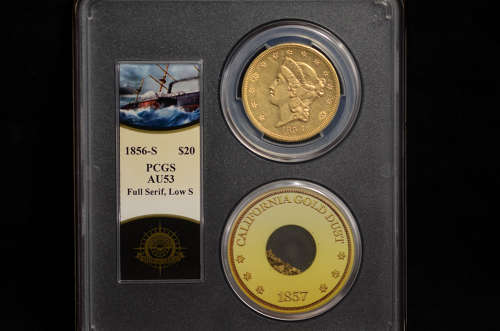

Code: 10389
S.S. Central America Ship wreck Treasure Coin, 1856-S gold twenty dollars, Full serif, low S. Encapsulated by PCGS along with a pinch of Californian gold dust. Graded as AU53. All housed within a specially made original cardboard presentation box, with gold letter embossed logo, along with the original certificate of authenticity from PCGS, signed by David Hall, the founder of PCGS.
Certification number: 670700.53/35058791.
From the fabled “Ship Of Gold” The S.S. Central America.
On 3 September 1857, 477 passengers and 101 crew left the Panamanian port of Colon, sailing for New York city under the command of William Lewis Herndon The ship was laden with 10 short tons (9.1 t) of gold prospected during the California gold rush. After a stop in Havana the ship continued north.
On 9 September 1857, the ship was caught up in a Category 2 hurricane while off the coast of the Carolinas By 11 September, the 105 mph (170 km/h) winds and heavy seas had shredded her sails, she was taking on water, and her boiler was threatening to fail. A leak in one of the seals between the paddle wheel shafts and the ship's sides sealed its fate. At noon that day, her boiler could no longer maintain fire. Steam pressure dropped, shutting down both the bilge pumps. Also, the paddle wheels that kept her pointed into the wind failed as the ship settled by the stern. The passengers and crew flew the ship's flag inverted (a distress sign in the US) to signal a passing ship. No one came.
A bucket brigade was formed, and her passengers and crew spent the night fighting a losing battle against the rising water. During the calm of the hurricane, attempts were made to get the boiler running again, but these failed. The second half of the storm then struck. The ship was now on the verge of foundering. Without power, the ship was carried along with the storm and the strong winds would not abate. The next morning, September 12, two ships were spotted, including the brig Marine. Only 153 passengers, primarily women and children, made their way over in lifeboats. The ship remained in an area of intense winds and heavy seas that pulled the ship and most of her company away from rescue. Central America sank at 8:00 that evening. As a consequence of the sinking, 425 people were killed. A Norwegian bark, Ellen, rescued an additional 50 from the waters. Another three were picked up over a week later in a lifeboat.
*The ship was finally rediscovered in 1987, in 8500 feet of water.